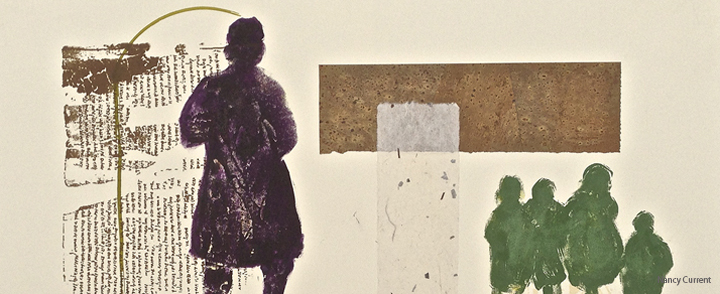By Emily K. Alhadeff, Associate Editor, The Jewish Sound
How do you see Torah?
That’s the question Nancy Current and Jeremy Alk will be asking upon the launch of their new class, “The Genesis of Creativity: Using Visual Midrash to Capture the Jewish Imagination.”
It’s not exactly a new question. Biblically inspired art is millennia old, and has come to form the popular imagination of what Creation, the Flood, Jacob’s ladder, the prophets, and even God look like.
But “visual midrash” and “artist beit midrash” are fairly new terms that refer to finding new artistic Biblical interpretations, inspired by the collection of rabbinic commentaries on the Bible. Originating out of the Skirball Center in Manhattan, classes are concentrated in New York and New Jersey, with one in Chicago. Inspired to start a similar program out west, Current, a Seattle-based mixed-media artist, went to the East Coast to research the small but growing artistic movement.
“It started by going to synagogue every week,” said Current, who attends Emanuel Congregation in Seattle’s Wedgwood neighborhood. “The poetry would jump out and clobber me between the eyes.”
She points to Psalm 97, which reads, “The Lord is King, the world will rejoice, numerous islands will be glad.”

“Numerous islands will be glad?” she recalls thinking. “What’s that? I had this picture in my head of joyful islands.”
The inspiration led to a series of colorful works on antique glass and LED panels. That got her started on a whole new area of artistic exploration.
“I don’t know what happened,” she said. “It was a revelation.”
Current then started exploring the Cairo Genizah and grafting reproductions of fragments onto glass.
“That got me so excited,” she said. “All I could see was how things got transmitted, l’dor vador [from generation to generation].”
The class, which will take place at Congregation Beth Shalom, will consist of an artist beit midrash, where participants will study midrashic commentaries on Genesis. Students will create their interpretive works using whatever medium they choose between classes.
“You sit around sometimes and think, ‘What is this thing about Jews and art’?” said Alk, an experienced Jewish educator with Congregation Beth Shalom who will be leading the text study.
From Tubal Cain to Bezalel, “There’s a lot in Torah that talks about art,” he said, not to mention the literary quality of the language and the incorporation of art into all aspects of Jewish life.
“You can cover your challah with a napkin, or you can cover it with a beautiful piece of cloth,” he added. “That makes Jewish life so interesting and beautiful.”
Alk plans to start with the Cain and Abel story, leading to Jacob’s ladder and Joseph’s coat of many colors, among others from Genesis. The beauty of midrash is expanding the text and playing with a story’s possibilities.
“How was the tree in the Garden of Eden eaten? Why was it eaten that way? To give a background, they speculate or they say, ‘This is how it happened.’ The midrashim give wider views of that event,” Alk said. “In the Torah text there’s a lot of stuff about doing things in a particular order. Art comes from putting chaos into order.”
Alk said he expects painters to show up to the class, but all forms of art are welcome.
“It’s just text study and making art, and you can just do what you want,” said Current.
But it’s more than just exploring art and text.
“There are a lot of people trying to find new ways to connect to their Judaism,” said Alk. “It’s just fascinating.”
